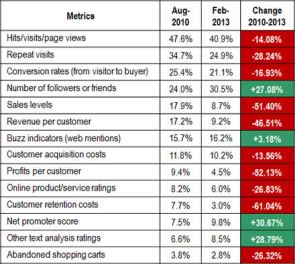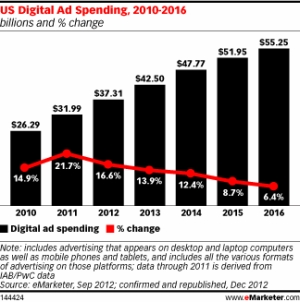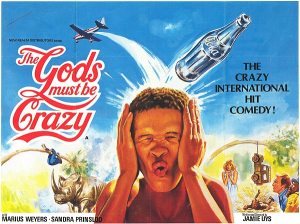Author Archives: Robbyn Brooks
ALL GOOD THINGS…
Posted by Robbyn Brooks
Robbyn’s Nest is evolving, not saying ‘goodbye’
The countdown has begun.
I graduate with my Master of Strategic Communication degree in five days. I am a journalist by trade, but the crises we examined, techniques we delved into and discussions we had during this yearlong process has made me a strategic communicator.
If you read back through the entries here at Robbyn’s Nest, you’ll find thoughts about advertising techniques, social media responses, technology that helps us communicate in ways we once only dreamed about and ideas that help us all analyze what we hear, see, read and relay. We’ve also taken a close look at what happens to companies, organizations and even people who have fallen behind the social media times to the detriment of a financial and reputational bottom line.
Because my classes are coming to an end, so is the weekly requirement for this blog. That said, it’s been fun to pass along ways we can all do our jobs better, and essentially be better communicators in our everyday lives. Communication helps us on all levels of relationships, from work, to the way we interact at home.
 This blog began as a way to further explore ideas being discussed in my graduate strategic communications classes, but will continue as a journal of thoughts, technology and advancements that allow professional communicators to do their jobs well – and with success.
This blog began as a way to further explore ideas being discussed in my graduate strategic communications classes, but will continue as a journal of thoughts, technology and advancements that allow professional communicators to do their jobs well – and with success.
The history of communication and its evolution, so far, is an interesting road. I can only imagine what the future will bring. I remember 20 years ago when I never would have thought I could make a phone call, email, Facetime, edit newspaper copy, video and update websites from one device. I am excited to continue studying strategic communication outside of school work and analyze new products and platforms on the horizon that can help professional communicators better relay messages and branding. Updates may not come as regularly as they do now, but I do hope you will stick around for the conversation to still be had.
‘NOT EVERYTHING THAT COUNTS CAN BE COUNTED’
Posted by Robbyn Brooks
It’s important to monitor social media ROI
We’ve explored the importance of using social media on this blog. We’ve talked about how companies should respond to crisis and when. We’ve talked about being present where consumers are. We’ve talked about monitoring the brand’s page to make sure to curb negative comments in a timely fashion. But, there is another aspect of social media that companies and strategic communications professionals must pay attention to – monitoring the success of social media use.
 Taking stock of social media return on investment (ROI) is a good way to decide what efforts work and what efforts should be kicked to the curb. “Half the money I spend on advertising is wasted; the trouble is I don’t know which half,” said department store mogul John Wanamaker. Wanamaker died in 1922, so the concept of tracking ROI isn’t a new one.
Taking stock of social media return on investment (ROI) is a good way to decide what efforts work and what efforts should be kicked to the curb. “Half the money I spend on advertising is wasted; the trouble is I don’t know which half,” said department store mogul John Wanamaker. Wanamaker died in 1922, so the concept of tracking ROI isn’t a new one.
In order to successfully measure ROI, companies should not only focus on how many followers and likes they receive, but also the impact that social media conversations and efforts have on overall sales and product image. That certainly means taking a step back and looking at the big picture when it’s so easy to see immediate gratification through clicks and views. The thought is to not solely rely on clicks and views, but to try and quantify what those mean in terms of increased sales.
 The CMO Survey took a look at metrics that companies use to measure the impact of social media efforts. They asked companies to share numbers in August 2010 and February 2013 to watch the change in results. Some of the categories were hits/visits/page views, number of followers or friends, sales levels and online product ratings. The results showed that while there was a 14 percent drop in website views, there was a 27 percent increase in the number of followers or friends as reported by the participating companies. An odd category, abandoned shopping carts, leads survey readers to believe that an increase in web mentions and social media followers trended 26 percent fewer shopping carts left abandoned in stores.
The CMO Survey took a look at metrics that companies use to measure the impact of social media efforts. They asked companies to share numbers in August 2010 and February 2013 to watch the change in results. Some of the categories were hits/visits/page views, number of followers or friends, sales levels and online product ratings. The results showed that while there was a 14 percent drop in website views, there was a 27 percent increase in the number of followers or friends as reported by the participating companies. An odd category, abandoned shopping carts, leads survey readers to believe that an increase in web mentions and social media followers trended 26 percent fewer shopping carts left abandoned in stores.
A May 2013 Forbes article analyzed the survey results and reported that social media impact has “first-order effects” when it comes to non-purchase behaviors. That includes people talking about companies and brands. That talk generates exposure, shapes attitudes and eventually leads to increased (or decreased) purchases.
We know that consumer talk about brands is a great way to boost brand loyalty and positive feelings about companies. However, strategic communicators and marketing professionals can’t simply stop at tracking how many mentions a company has on Twitter. That number means little to nothing if a company can’t tell what the sentiment behind the numbers is. Is the conversation positive or negative? Companies such as Viral Heat, Twendz, Tweet Feel, and Sentiment Metrics all provide sentiment analytics for Twitter mentions. The old addage “any publicity is good” doesn’t ring true for brands. All it takes is one negative comment on Twitter to be retweeted to friends and by celebrities to send a company in a downward brand spiral.
While companies might not understand the intangibles behind social media marketing, tangibles can be measured that prove the technique can be successful or detrimental. Social Media Today suggests that results achieved by social media come from some intangibles created by social media efforts, including:
- A positive or negative emotional reaction from brand communications.
- The acknowledgement of being heard.
- The feeling of not being just a dollar sign to a brand, rather than a valuable person.
- The feeling that the brand is trustworthy, transparent and open to dialogue from consumers.
- The sense of recognition for contributing to the value of a brand.
- The ability to influence others who share similar sentiments about anything, everything and anyone.
- The connectivity people feel from human, rather than institutional, communications.
BFG Communications content manager Hal Thomas spoke to a portion of the DMA2011 conference and said, although social media ROI may be “fuzzy,” there are things companies can keep in mind to help measure social media success.
- Social media is the vehicle, not the destination, according to Thomas. He further explained that marketing professionals mistakenly think that having a media presence on Twitter or Facebook is “the destination,” when it is really a communications tool that carries a company to a larger goal – profit.
- Listen and apply what you learn. Thomas said the number of likes and comments generated on social media sites is great, but what do they mean. Take time to see what posts and thoughts receive the most interaction on social media sites. If more consumers comment on one product over another, it could be a way to notice how consumer preference is trending. That offers companies a direction point when it comes to how they might invest dollars in the future.
- Understand how social media is used in an organization. Thomas notes that different departments within a group measure success in different ways and social media metrics will mean different things to different departments. Each measure of success should be based on a department’s specific goals.
Trying to measure the success of social media efforts isn’t for the impatient. Brands must be built on social media  networks over time and kept up with constant updates and interactive features that enable a consumer’s voice to be heard. It is only when working ahead for a positive brand image that companies can be prepared to battle the negative that could arise – as a result of anything from a poor customer service experience to a product recall. Over time, companies should be able to track the effects of their social media interaction through a boost in sales, a shift in brand image and an increase in overal popularity.
networks over time and kept up with constant updates and interactive features that enable a consumer’s voice to be heard. It is only when working ahead for a positive brand image that companies can be prepared to battle the negative that could arise – as a result of anything from a poor customer service experience to a product recall. Over time, companies should be able to track the effects of their social media interaction through a boost in sales, a shift in brand image and an increase in overal popularity.
Are their any brands you believe are monitoring the ROI of social media? For me, just based on the efforts exerted by the social media team and perceived popularity, I believe Starbucks is. They have a reputation for customer service and that extends to their efforts on Facebook, Twitter, Pinterest and Google+. And the company listens. Did you know the stirrer/stopper you get at Starbucks was actually the creation and suggestion of a loyal customer? Can you think of any other companies who use social media to their benefit?
TOMORROW IS TOO LATE
Posted by Robbyn Brooks
Companies must jump on the social networking bandwagon, now
Tomorrow is too late when it comes to crisis management. A text book we used early on during the grad school program I am in suggested that 24 to 48 hours was a suitable time to respond to an issue or crisis. Most public relations professionals worth their salt today would laugh at that number. If you aren’t involved in a conversation about a crisis within 30 minutes of it happening, you’re playing catch-up through the whole ordeal and company branding and trust is likely to be damaged.
Think back to the Chick-fil-A blunder, BP’s big mistake and the Domino’s disaster.
 We live in a 24-hour news cycle world. People log on to Facebook in the morning to talk about what they ate for breakfast, hipsters instagram photos of bricks and sidewalks or ironic signs like they’ve never seen them before and more than two million active Twitter users tweet and retweet as fast as they can type 140 characters. Companies simply don’t have the luxury of taking a step back to decide a method of response these days. Plans should be thought out in advance and must be carried out in a multi-front way.
We live in a 24-hour news cycle world. People log on to Facebook in the morning to talk about what they ate for breakfast, hipsters instagram photos of bricks and sidewalks or ironic signs like they’ve never seen them before and more than two million active Twitter users tweet and retweet as fast as they can type 140 characters. Companies simply don’t have the luxury of taking a step back to decide a method of response these days. Plans should be thought out in advance and must be carried out in a multi-front way.
“The savvy journalists are not waiting by their fax machine for an official press release, but are ready to quote live accounts of passengers and bystanders being shared online,” wrote Shashank Nigam on Simpliflying.com in response to the July 2013 Asiana Airlines 214 crash in California. Nigam noted that Asiana Airlines was the major voice not present in the world-watched aftermath of the crash. It’s important to the success of modern companies, such as those in the airline industry, to be present where conversations are being had. Anyone with a smartphone can upload information or photos of breaking news and company displeasure. And with LTE service and WiFi increasingly available, spreading news via social media can happen with ease. That means, industry professionals must monitor Twitter, Facebook, YouTube and any other social media outlet that takes off. Ideas of controlling information go out the window considering social media. Issues must be addressed on all fronts. Tales of angry customers taking to Twitter and Facebook to bash brands happens so often that companies must understand the time to shift the way they respond to both digital and traditional methods is now.
 Nigam noted that while the voice of Asiana Airlines wasn’t heard, a clear and loud (but calm) voice echoed over social media. David Eun, former president of AOL Media and Studios, tweeted, “I just crash landed at SFO. Tail ripped off. Most everyone seems fine. I’m ok. Surreal…” Eun was a passenger on the July 6, 2013 Asiana airplane crash. His tweet, coupled with a photo, was retweeted 32,700 times and his 2,000 person Twitter following increased about 10 times just hours following the crash. Simpliflying reported that the first tweet about the crash happened just 30 seconds after the crash and that tweet was quoted more than 4,000 times by media outlets in a period of 24 hours. “The lesson learnt is that social media needs to be an integral part of any crisis management plan for an airline or an airport today. There is no longer the luxury to respond in two hours, or even 20 minutes,” Nigam posted on the website.
Nigam noted that while the voice of Asiana Airlines wasn’t heard, a clear and loud (but calm) voice echoed over social media. David Eun, former president of AOL Media and Studios, tweeted, “I just crash landed at SFO. Tail ripped off. Most everyone seems fine. I’m ok. Surreal…” Eun was a passenger on the July 6, 2013 Asiana airplane crash. His tweet, coupled with a photo, was retweeted 32,700 times and his 2,000 person Twitter following increased about 10 times just hours following the crash. Simpliflying reported that the first tweet about the crash happened just 30 seconds after the crash and that tweet was quoted more than 4,000 times by media outlets in a period of 24 hours. “The lesson learnt is that social media needs to be an integral part of any crisis management plan for an airline or an airport today. There is no longer the luxury to respond in two hours, or even 20 minutes,” Nigam posted on the website.
Need more proof digital is the way to go?
Morrison Foerster’s hosts a Socially Aware blog that discusses the Internet and social media boom and how that relates to consumers and businesses. The blog released findings in November 2012 regarding how many people use different social media outlets, and how much time they spend on which outlets. The blog reported that, in 2011, the average American spent 6.9 hours each month using social media. That’s nearly a full work day minus a lunch break. That number was up from social media users spending 2.7 hours each month tweeting and “liking” in 2006. Three hours each month was spent on YouTube in 2011, according to Socially Aware. Another interesting shift in interactive time reported by the blog is that email and instant messaging fell 22 percent and 42 percent, respectively, while social media use rose 24 percent between July 2010 and October 2011 when it comes to 15 to 24 year olds. Other age groups reflected that shift, too. The fastest growing social networking user segments are males and people older than 55, Socially Aware reported. Although numbers are likely to have increased in the year following the blog’s findings, in 2012, 56 percent of Americans had a social networking profile and 22 percent of people in the United States use social media several times each day. Social media accounted for 18 percent of all time spent on line in 2012, the numbers showed. My guess is that number has grown by now.
Still not convinced digital is the way to go? Here are some quick numbers that show the shift is valid.
A 2012 Neilsen survey found that 18- to 24-year-olds, of whom half make less than $15,000, said they own a smartphone. The device was a luxury the young adults said they weren’t willing to do without. The Pew Internet Project found that, in 2011, 35 percent of those the group called for a survey said they owned a smartphone. Nine out of 10 smartphone owners surveyed used their phones for Internet access with about 78 percent doing so every day. Cisco Visual Networking predicted that by the end of 2012 there would be more smartphones than people on the planet and that by 2016, there would be 1.4 smartphones per person on Earth. With the growth of smartphone ownership and the ever-developing world of social media applications for phones and tablets, future crisis and issues management researchers should keep an eye on any developments that could make it even easier for consumers to make their voices heard.
Social media, for better or worse, is a fast way for news to travel. Companies should be pro-actively looking for ways to get in on the conversation, both before and after a crisis.
Posted in Journalism, New Media, Public Relations, Social Media, Strategic Communications, Technology
Tags: Asiana Airlines, crash, facebook, Instagram, like, smartphones, social media, tweet, Twitter
PAYING TO BE FIRST IN LINE
Posted by Robbyn Brooks
Search ads and digital advertising continues to grow
Companies fork out billions upon billions of advertising dollars each year to make sure business stays on the upward climb. And to do that, there’s been a shift to digital advertising. That is a shift that’s only natural, considering that people spend more and more time on their computers and smartphones and less and less time in front of a printed newspaper or listening to the radio.
 According to an eMarketer article from 2012, Google, Yahoo!, Microsoft, Facebook and AOL were expected to take in just under $24 billion in advertising revenue that year. By 2014, Google’s growth was expected to see marketers spending more than $20 billion with $3 billion more going to other digital efforts. It’s also been reported that in 2012, Google made more in the first six months of the year (almost $21 billion) than all U.S. print media industry combined (just more than $19 billion).
According to an eMarketer article from 2012, Google, Yahoo!, Microsoft, Facebook and AOL were expected to take in just under $24 billion in advertising revenue that year. By 2014, Google’s growth was expected to see marketers spending more than $20 billion with $3 billion more going to other digital efforts. It’s also been reported that in 2012, Google made more in the first six months of the year (almost $21 billion) than all U.S. print media industry combined (just more than $19 billion).
Leading the pack in what companies are paying Google for are search ads. Those are the ads that look a whole lot like regular links that pop up after a Google search. They are highlighted in a very light pink color, so to the Internet unsavvy, it’s hard to distinguish those ads from news and organization links that aren’t paid for. The way it works is, companies pay to have their links come in in searches for words. For instance, if you search for the keyterm “pools,” pool companies that pay Google will come up above all other listings. Seems like a great way to market a product, right? It’s a sure fire way to always make sure your name comes up on top. The downside is, those search ads can be used to deceive the public too.
 In 2010, BP paid to have its website rank higher on search results to bolster the company’s image. They bought into search terms such as “oil spill,” “volunteer,” and “claims.” BP wouldn’t say how much they paid for the service, but they spent more than $50 million on television ads to make themselves look better. Google doesn’t permit news sites and blogs to promote with search ads, so if a person was looking for unbiased reporting on the oil spill in the Gulf of Mexico, they would first have to make it beyond the BP controlled ads that linked to the company’s “Gulf of Mexico Response” page filled with videos and articles explaining how BP was resolving the issue. The use of the search ads was highly publicized and consumers admitted they felt tricked by BP. BP could have probably better used those millions of dollars to pay claims and perform actual clean-up to get back in the good graces of the country instead.
In 2010, BP paid to have its website rank higher on search results to bolster the company’s image. They bought into search terms such as “oil spill,” “volunteer,” and “claims.” BP wouldn’t say how much they paid for the service, but they spent more than $50 million on television ads to make themselves look better. Google doesn’t permit news sites and blogs to promote with search ads, so if a person was looking for unbiased reporting on the oil spill in the Gulf of Mexico, they would first have to make it beyond the BP controlled ads that linked to the company’s “Gulf of Mexico Response” page filled with videos and articles explaining how BP was resolving the issue. The use of the search ads was highly publicized and consumers admitted they felt tricked by BP. BP could have probably better used those millions of dollars to pay claims and perform actual clean-up to get back in the good graces of the country instead.
But hold on, Google, you may be raking in the money now, but someone is looking to take your place. Bing just keeps plugging away at an effort to make the company as popular as Google. Recently, Microsoft has paid for Bing to appear in the movie Source Code and the television show The Vampire Diaries. The company even ran an ad during the popular AMC show The Walking Dead after efforts to have Bing inserted in the show failed. The biggest call out Bing received for product placement, however, was with its use in The Amazing Spiderman when Peter Parker uses Bing as a search engine. Nerds united saying that a nerd like Peter Parker would never use Bing. However, the company’s efforts might be paying off. Bing has garnered about 30 percent of the search market when taking into consideration that Yahoo! is Bing powered.
In addition to search ads, companies can place digital advertisements on news websites, social media sites, blogs and other online locations and applications. But where those ads are placed and what they look like bakes a big difference as to whether or not the message is seen by consumers. The Poynter Institute’s Eye Tracking Study is a good read for marketers looking to get the most bang for their buck online. Pointer found out that Net surfers spend a lot of time looking at the top left of pages and in the upper section as a whole before moving down and to the right. That’s because normal initial eye movement focuses around the upper left part of the screen. The Poynter study indicated that ads work better in the left hand column instead of the right hand column because the right side of the page is an “after thought.” Also, text ads were viewed the most closely of all the ones Poynter looked at. They are less distracting and camouflage well with other page content. Bigger ads have a better chance of being seen and the bigger an image, the more time people take to survey it.
 Digressing a little bit from digital advertising (because this is my blog and I can if I want to) to the importance of viewing repetition and it’s importance to branding, when I was looking at Bing’s efforts with product placement, I began to think about companies who use it well. My husband and I were just at a movie last night and there’s no doubt that Coca-Cola has the market on movie product placement. The company believes that repetition and and brand association goes a long way in the minds of consumers, and judging by how much they spend at the movies, they must be right. Over the last 80 years, Coke products have been in iconic films such as It’s a Wonderful Life, King Kong, The Exorcist, E.T., Jaws, Batman, Independence Day, The Gods Must Be Crazy and many others. AnyClip used tagging technology to try and pinpoint how much time Coke products received on camera over the years. (There’s a pretty nifty infographic at the link.) AnyClip found that there was a relationship between a film’s budget and the amount of time Coke products appeared on screen in a movie. Of all the time spent on screen Coke products appeared 32 percent in cans, 20 percent on signs, 18 percent in bottles, 12 percent in glasses, 7 percent in cups and 11 percent “other.” Coke’s brand influence in movies is 9.7, Apple is at 9.1 and Toyota comes in at 7.5.
Digressing a little bit from digital advertising (because this is my blog and I can if I want to) to the importance of viewing repetition and it’s importance to branding, when I was looking at Bing’s efforts with product placement, I began to think about companies who use it well. My husband and I were just at a movie last night and there’s no doubt that Coca-Cola has the market on movie product placement. The company believes that repetition and and brand association goes a long way in the minds of consumers, and judging by how much they spend at the movies, they must be right. Over the last 80 years, Coke products have been in iconic films such as It’s a Wonderful Life, King Kong, The Exorcist, E.T., Jaws, Batman, Independence Day, The Gods Must Be Crazy and many others. AnyClip used tagging technology to try and pinpoint how much time Coke products received on camera over the years. (There’s a pretty nifty infographic at the link.) AnyClip found that there was a relationship between a film’s budget and the amount of time Coke products appeared on screen in a movie. Of all the time spent on screen Coke products appeared 32 percent in cans, 20 percent on signs, 18 percent in bottles, 12 percent in glasses, 7 percent in cups and 11 percent “other.” Coke’s brand influence in movies is 9.7, Apple is at 9.1 and Toyota comes in at 7.5.
LEAD, OR PREPARE TO BE LEFT BEHIND
Posted by Robbyn Brooks
Businesses need leaders, not just managers
It’s easy to think of people who were considered great leaders for one reason or another. John F. Kennedy united a generation, Ghandi taught compassion, Rosa Parks held her ground during the Civil Rights Movement. They are all remembered for different things, but all three shared something in common – vision.
Vision is what separates leaders from managers. That’s not to say that one person can’t be both. However, the functions of leaders and managers is vastly different at the core when it comes to their goals and jobs within an organization.
 Warren Bennis shared his thoughts on what differentiates leaders and managers in his book On Becoming a Leader. Bennis said that a leader’s purpose is innovation while a manager is an administrator. It’s the leaders job to push a company forward with new ideas, strategies and tactics. It’s also a leader’s job to always be looking ahead at ways for companies to implement new technologies. Bennis also wrote that leaders inspire people and a manager’s responsibility is to maintain control over certain areas of the company. The third idea Bennis brings forward is that leaders ask “what” and “why,” while managers focus on “how” and when.”
Warren Bennis shared his thoughts on what differentiates leaders and managers in his book On Becoming a Leader. Bennis said that a leader’s purpose is innovation while a manager is an administrator. It’s the leaders job to push a company forward with new ideas, strategies and tactics. It’s also a leader’s job to always be looking ahead at ways for companies to implement new technologies. Bennis also wrote that leaders inspire people and a manager’s responsibility is to maintain control over certain areas of the company. The third idea Bennis brings forward is that leaders ask “what” and “why,” while managers focus on “how” and when.”
Larger organizations have the luxury of hiring both managers and leaders. Leaders are the “think tank” of the group while managers are paid to make sure a leader’s plan is followed through. One personal example of an organization I’ve worked with that maximized use of both leaders and managers is People for the Ethical Treatment of Animals. I know everyone has mixed feelings on the group, and I ask you as a strategic communicator to put those biases aside and focus on what has been wildly successful for a company that is located on several continents and boasts two million members.
 The clear leader of PETA is Ingrid Newkirk, who is also the co-founder of the organization. She is engaging and inspiring, both charismatic traits of successful leaders. But beyond that, she’s build the organization on the thought that people can be trusted with delegated ideas. Newkirk is a large part of the “think tank” for PETA. She is hands on and hosts a companywide morning meeting with all offices via an Internet roundtable. Newkirk sparks thoughts and ideas about new campaigns and then trusts managers in different divisions – such as Laboratory Investigations, Communications and Campaigns – to bring back plans to implement those ideas. It’s a well-oilded machine that is impressive, no matter what your view on the company’s policy is.
The clear leader of PETA is Ingrid Newkirk, who is also the co-founder of the organization. She is engaging and inspiring, both charismatic traits of successful leaders. But beyond that, she’s build the organization on the thought that people can be trusted with delegated ideas. Newkirk is a large part of the “think tank” for PETA. She is hands on and hosts a companywide morning meeting with all offices via an Internet roundtable. Newkirk sparks thoughts and ideas about new campaigns and then trusts managers in different divisions – such as Laboratory Investigations, Communications and Campaigns – to bring back plans to implement those ideas. It’s a well-oilded machine that is impressive, no matter what your view on the company’s policy is.
On the opposite end of the manager/leader spectrum are small companies that can’t afford to employ both managers and leaders. Traits of both are required for positions of management, and if that fails to happen, companies can also fail. According to a management-leadership article by the Wall Street Journal, “…in the new economy…management and leadership are not easily separated. People look to their managers, not just to assign them a task, but to define them for a purpose. And managers must organize workers, not just to maximize efficiency, but to nurture skills, develop talent and inspire results.”
Since this is a communications blog, let’s focus on the declining newspaper industry. I’ve been in the newspaper field for about seven years out of my 12 years in the communications field and it saddens me, just as it does many other print journalists, to recognize that if the industry doesn’t shift it will die. When I went to work for a daily newspaper in Florida in 2005, there were more than three hundred employees there. When I left that paper in 2009, there were less than about 50. The Chicago Sun-Times let go its entire photography staff recently with the thought that reporters could provide photos and video themselves. Let’s leave out the idea that the documentation of emotion will likely suffer and just focus on the shift to the idea of “one-man-bands.” Television stations shifted to that idea years ago, which just shows that newspapers are still catching up when it comes to innovative ideas.
To be in the newspaper industry these days, and be successful, and have the company remain successful, employees have to wear multiple hats. That especially goes for people in management positions. Managers at small community newspapers are tasked with writing, editing, planning the daily product, taking photos, editing photos, laying out pages, public relations and customer service, but above all, managers must focus on vision and leadership. In the middle of all the managerial work to be done, if editors don’t also understand the importance of propelling a news organization forward with technology and communication, messages can be lost and products become irrelevant.
 In 2006, Time Magazine asked if newspapers had a future and The Economist predicted print media would dissolve by 2043, posing thoughts as to who was responsible for the industry’s decline. While those answers may not have been clear seven years ago, I have very strong feelings on the issue today. Will newspapers survive? Yes. But not without re-invention. Will they be printed on newsprint and delivered on front door steps by 2043? Probably not unless a company finds a way to market nostalgia. Who is killing newspapers? Managers who lack vision.
In 2006, Time Magazine asked if newspapers had a future and The Economist predicted print media would dissolve by 2043, posing thoughts as to who was responsible for the industry’s decline. While those answers may not have been clear seven years ago, I have very strong feelings on the issue today. Will newspapers survive? Yes. But not without re-invention. Will they be printed on newsprint and delivered on front door steps by 2043? Probably not unless a company finds a way to market nostalgia. Who is killing newspapers? Managers who lack vision.
Newspaper managers and editors must move forward to communicate with readers where communication is happening. Right now, conversations are being had via Twitter and Facebook. Some years ago it was MySpace. Even before that, information was passed along via email links and forwards. Figuring out a way to keep a news product relavant by becoming a multi-media agency versus a traditional newspaper is key to the industry’s reinvention and survival.
 In small communities where I live, it’s a struggle to maintain a balance still because the county is rural and many subscribers to the print product don’t have access to the Internet. Some community members read about our online poll in the print edition and call the office to ask if we can enter a vote for them (which we do). Moving forward without leaving paying subscribers behind is an issue we face daily.
In small communities where I live, it’s a struggle to maintain a balance still because the county is rural and many subscribers to the print product don’t have access to the Internet. Some community members read about our online poll in the print edition and call the office to ask if we can enter a vote for them (which we do). Moving forward without leaving paying subscribers behind is an issue we face daily.
However, metro areas such as Washington, D.C., are succeeding in seeing newspapers become a digital 24-hour news source. That’s thanks, at least in part, to the vision of leaders at metro papers.
I’d love to hear how you all get your news? Do you find some nostalgia in picking up a printed newspaper and sipping a cup of coffee, or do you prefer the convenience of reading news on a tablet or smartphone?
SOMETIMES YOU HAVE TO LOOK WITHIN
Posted by Robbyn Brooks
Don’t forget about employees when it comes to the communication process
When professionals talk about communication, its common to focus on branding an image in public or sparking conversation with clients and customers. However, one of the most important groups of people organizations should consider during communication plans is employees.
 Employees are often times the first representatives of a company or organization that the public comes in contact with. Family members become familiar with a company because a loved one works there. The same goes for friends and acquantances. Employees can act as wonderful spokespeople, or in some cases where they don’t feel their opinions and skills are valuable to a company, employee opinions can be damaging to a company’s image.
Employees are often times the first representatives of a company or organization that the public comes in contact with. Family members become familiar with a company because a loved one works there. The same goes for friends and acquantances. Employees can act as wonderful spokespeople, or in some cases where they don’t feel their opinions and skills are valuable to a company, employee opinions can be damaging to a company’s image.
Building loyalty on the inside translates to a positive message being spread along an external grapevine. Employees are looked at as credible representations of a business.
 David Brown writes for The Business Review and suggests, “Without a dedicated, effective internal communications program, an organization allows others to determine what information (or disinformation is communicated to employees about their organization.”
David Brown writes for The Business Review and suggests, “Without a dedicated, effective internal communications program, an organization allows others to determine what information (or disinformation is communicated to employees about their organization.”
So how should companies go about fostering open and successful communication with employees? The Globe and Mail has these suggestions.
- Create a common company language. Every type of business has lingo they use. It’s important for all employees to understand the language so that messages can be clearly deciphered and understood. When I worked as a public relations professional for a non-profit in Washington, D.C., I was thrown in the mix without knowing what a NRRF (news release request form), MC (media calendar), and EOD (end of day) were. Don’t just assume people know what you are talking about. Teach them.
- Understand your company culture. If communication isn’t considered important in your company, change that. Make the business open and promote two-way conversations. Just because you don’t have a policy of transparancy now, doesn’t mean you can’t make a shift.
- Create internal social networks. (We’ll come back to this a little later in this post.) Understand that both formal and informal communication is important. Tasks and serious communication should be done formally through email and memos, but social communication fosters understanding and relationshps between the company’s subordinates and higher ups. Getting to know people on a personal level is important to the environment of a business or organization.
- Understand information sharing. While the non-profit I mentioned above didn’t do so well when it came to personally sharing what abbreviations and acronyms meant, they did have a solid plan in place for cross-training and helping employees understand step-by-step procedures. There was a whole databank of SOPs (standard operating procedures) that listed detailed directions for doing most tasks, from submitting requests, to reading up on how other departments worked. Consider creating a forum or space on your network to set employees up for success by providing information.
- Encourage employee participation. Speaking up is hard. It can be difficult whether you are a veteran or a rookie at a company. The key is for management to make it clear opinions are wanted, and needed, for the companies success. Help employees understand there is nothing wrong with speaking their mind. That technique ensures a full communication of both good and bad things without fear of repurcusion.
- Have a solid social media policy. A summer intern who worked with my newspaper last year made a big mistake, dispite having “listened” to instructions about inappropriate ways to represent a company. During a recreation league baseball game he was assigned to cover, he tweeted something like, “Shoot me. Having to cover little kid baseball for the newspaper.” Later he followed it up with a, “These kids can’t even score a run. F*** you, Troy.” Obviously, that is not a great representation of the employees who work hard on a daily basis to cover the community. Make sure there is a social media policy in place and instruct employees about the proper ways to talk about the company, if at all, online. Social media policy is also a disccusion when it comes to appropriate ways for employees to communicate with each other and with their bosses. Lines need to be drawn to protect both the company and employees.
Now, back to the internal social network bulletpoint listed above. Of course companies use email, but now that’s a forum best used for more formal communication or one-on-one communication. Some organizations have created forums with different topics for different discussions. Still, other businesses promote the use of LinkedIn as a way to get to know and communicate with other employees. But then there are groups who have jumped on the social media train with Twitter-like communication efforts, such as BizTweet, a corporate Twitter decisioning software.
 BizTweet has worked externally for companies such as Delta, but internally for businesses like LG CNS Co. who use the product to communicate between employees. At first, the company admitted it was worried the process would become to much like a social media water cooler, but employees usually stuck to work-related topics – including setting up lunch meetings with collegues. Let’s face it, most employees don’t have push notifications for emails on their phones, but most Twitter users have smartphones set to show new tweets come across from selected accounts. It’s an easy and timely way to get information to employees and for them to communicate back. There’s even a BizTweet Daily newsletter to get even more ideas about how to use the platform to promote companies both internally and externally. While it doesn’t look as if BizTweet has taken off with the success of Twitter, the original product may be even a better platform for organizations to use, afterall, many employees already have a Twitter account. Companies can simply set up a private Twitter account that is only open to employees. Easy breezy!
BizTweet has worked externally for companies such as Delta, but internally for businesses like LG CNS Co. who use the product to communicate between employees. At first, the company admitted it was worried the process would become to much like a social media water cooler, but employees usually stuck to work-related topics – including setting up lunch meetings with collegues. Let’s face it, most employees don’t have push notifications for emails on their phones, but most Twitter users have smartphones set to show new tweets come across from selected accounts. It’s an easy and timely way to get information to employees and for them to communicate back. There’s even a BizTweet Daily newsletter to get even more ideas about how to use the platform to promote companies both internally and externally. While it doesn’t look as if BizTweet has taken off with the success of Twitter, the original product may be even a better platform for organizations to use, afterall, many employees already have a Twitter account. Companies can simply set up a private Twitter account that is only open to employees. Easy breezy!
Last, but not least, to remember if you are a management employee communicating to the masses. Forget the leadership and manager jargon. Talk to employees as people, not as subordinates. Use inclusive terms such as we and our instead of me and I. Helping employees feel part of a team goes a long way down the road to communication success!
CREATING A VIRAL INFECTION
Posted by Robbyn Brooks
Companies need social media presence, but don’t always play fair
We’ve all seen what happens when companies fail to respond to a crisis where people are talking about it. BP took a hit, Chick-fil-A took a big hit – all because they failed to respond in a timely matter to discussion that was happening where they weren’t present. In the case of BP, the company allowed someone else to set the tone of their response to the Gulf oil spill. They weren’t talking and didn’t really have an established social media presence, so someone else created a presence and did the talking. And that someone else was callous and funny, contributing not only to the thought that BP was hiding from consumers, but also adding negative thoughts about the company to people’s mindsets. In Chick-fil-A’s case, the company already had an established social media presence, especially on Facebook, but they didn’t use it. It took about two days for the company to respond to allegations that Chick-fil-A was anti-gay. That’s way too long in terms of crisis response.
From watching national companies tank at their responses, and also pull themselves out of a crisis with social media, we’ve learned that it’s best to have a positive social media interaction with consumers before a crisis happens. Already having an open line of communication is key, along with establishing a responsible and creative image for a company.
 Many companies are realizing the benefits to being proactive when it comes to creating content and reaching the maximum number of viewers by making their messages and videos go viral. Advertising Age releases a list each Thursday of the top 10 viral ad videos each week. Check them out. Some of them have also appeared on television, like this week’s highlighted American Express “This is What Membership is” commercial with more than 1.5 million views on YouTube. Others are primarily online campaigns or foreign efforts such as the Melbourne Metro Trains release “Dumb Ways to Die” with nearly 1.9 million views. It has a catchy little tune and although it’s on the longer side (an advertising no-no these days), I can see why people would watch every second of it.
Many companies are realizing the benefits to being proactive when it comes to creating content and reaching the maximum number of viewers by making their messages and videos go viral. Advertising Age releases a list each Thursday of the top 10 viral ad videos each week. Check them out. Some of them have also appeared on television, like this week’s highlighted American Express “This is What Membership is” commercial with more than 1.5 million views on YouTube. Others are primarily online campaigns or foreign efforts such as the Melbourne Metro Trains release “Dumb Ways to Die” with nearly 1.9 million views. It has a catchy little tune and although it’s on the longer side (an advertising no-no these days), I can see why people would watch every second of it.
Viral videos, whether instructional or just entertainment, can establish a positive image for a company and reach a larger audience than regular customers. Take a look at the Pepsi “Harlem Shake” video featuring Jeff Gordon. There is absolutely no point to the effort other than to make the company relevant considering pop culture. Point or not, the video has garnered almost 7 million views just on Pepsi’s original upload. That doesn’t include all users who re-uploaded the video to their own YouTube channels.
 So what’s the trick to creating a viral video and getting it seen by millions? According to The Commotion Group, many companies don’t leave going viral to chance. They pay big bucks to make it happen. Here are some tips from Dan Ackerman Greenberg, co-founder of the group and lead TA for the Stanford Facebook Class. Greenberg said he and his coworkers run a “clandestine” effort to make videos go viral for companies – including movie studios, record labels and other businesses.
So what’s the trick to creating a viral video and getting it seen by millions? According to The Commotion Group, many companies don’t leave going viral to chance. They pay big bucks to make it happen. Here are some tips from Dan Ackerman Greenberg, co-founder of the group and lead TA for the Stanford Facebook Class. Greenberg said he and his coworkers run a “clandestine” effort to make videos go viral for companies – including movie studios, record labels and other businesses.
- Keep it on the short side: A 15-30 second video is the best plan to keep people watching.
- Think in terms of remixing: Create a product that others can remix and pass along. (Dramatic hamster.)
- Don’t think you can just create an ad: Viewers won’t share videos unless they find them interesting and unique. Don’t make it feel like just another advertisement. (Sony Bravia)
- Don’t underestimate shock value: Create a reason for viewers to investigate the video further. (UFOs in Mexico)
- Fake it: Fudge and use headlines that are sensational (Stolen Nascar).
- If all else fails, remember sex sells: Put attractive people in videos. That’s simple. Remember Yoga 4 Dudes from a while back? Or any of PETA’s Superbowl commercials?
Once you have a video, it’s important to market it in the right places. It’s estimated that tens of thousands of videos are uploaded to YouTube everyday and about 80 million videos get seen. The key to becoming noticed on YouTube is getting on the “most watched” page, Greenberg said. To do that, you need at least 50,000 views. That means you have to get people to watch the video before you can make it go viral. In an earlier blog, we discussed opinion leaders and the importance of marketing items to them and not just the masses. Making a viral video is no different. Reach out to established bloggers who would find the content relevant, start threads and embed videos on forums, share to the max on Facebook and Twitter and don’t forget about friends. Everyone that you and your mother and your brother know should also know that you’ve created a cool video. Be shameless when it matters.
Other tricks that Greenberg shared are just that, a little tricky. So you may have to battle some ideas about ethics in advertising to get beyond them. One of those ideas is to “optimize” video titles. That means making it misleading to start with and then changing the title to be relevant to a brand after a few days. Another thought is to choose the most outrageous image to be the thumbnail displayed for the video. And another is to create multiple user accounts to have conversations about the video – with yourself.
While some of those tips might give the most ethical communications professional some heartburn, Greenberg said his methods work – citing that his company doesn’t get paid unless a video achieves at least 100,0000 views. Even so, Business Insider has some other ideas about how to create viral videos. Those are a little more tame and a little less “iffy.”
Even if you don’t agree with the idea of businesses tricking consumers into helping their videos go viral (it kind of takes some of the “warm and fuzzy” feeling out of the process), it’s interesting, also, as a consumer to see ways that we are tricked into helping spread a brand’s message.
What are some of your favorite viral videos? Here are three of my favorites, although they aren’t branding videos: Surprise Kitty, Charlie Bit My Finger, Scary Maze.
CONSUMERS LET FINGERS DO THE WALKING
Posted by Robbyn Brooks
Social media, opinion leaders drive consumer purchases
Who do you listen to and about what? Think about the last time you purchased a vehicle, why did you choose that one? When it comes to movies, do you base your picks on reviews by professionals or friends? Do you buy your clothes because you saw a celeb rocking an outfit? And, do you have at least one obscure band that is on your playlist? How did you find them?
The truth is, we are influenced everywhere we turn through different layers of opinion leaders in our lives – those are the people we trust, for whatever reason, to give us decent advice on the things we need and want. Back in the early years of opinion leaders, those people were mostly government officials, industry experts, celebrities and anyone else who broadcast and newspaper journalists thought were worthy of inclusion in coverage and reviews.
 Now, anyone with a smartphone or tablet can be an opinion leader with a little bit of work. Upload enough interesting content to YouTube, tweet enough in 140 characters and gather Facebook friends through creative methods and you, too, can be an opinion leader. Enough followers through social media means that those account holders reach those followers. It first may be through witty content, and after the user is in favor with followers, those followers begin to trust the account holder for other things.
Now, anyone with a smartphone or tablet can be an opinion leader with a little bit of work. Upload enough interesting content to YouTube, tweet enough in 140 characters and gather Facebook friends through creative methods and you, too, can be an opinion leader. Enough followers through social media means that those account holders reach those followers. It first may be through witty content, and after the user is in favor with followers, those followers begin to trust the account holder for other things.
Want to be an opinion leader? The Wall Street Journal has a few tips on how to use social media to strengthen your leadership skills.
 First tip: Stop looking at social media as another thing you have to learn and realize the outlet can help you reach new ideas and a wider audience. Next up, embrace those 140 characters that Twitter has to offer. Twitter is a great way to get out key ideas to a large group of people without burdening them with one more email or phone call. Tweets are short and sweet, millions of Tweeps agree, that’s the way they like their messages. Also, consider joining in some social circles online. Reading what like-minded leaders have to say will give you ideas and also boost credibility through association. Finally, the WSJ says social media can be used to “amplify your voice.” If the thought of blogging, tweeting and Facebooking on top of everyday tasks is daunting, just realize that you can repurpose info you are already sending out. For instance, if you would normally email a link to a new blog or a new idea – Tweet it, post it to Facebook or create a short YouTube video blog to appeal to the masses.
First tip: Stop looking at social media as another thing you have to learn and realize the outlet can help you reach new ideas and a wider audience. Next up, embrace those 140 characters that Twitter has to offer. Twitter is a great way to get out key ideas to a large group of people without burdening them with one more email or phone call. Tweets are short and sweet, millions of Tweeps agree, that’s the way they like their messages. Also, consider joining in some social circles online. Reading what like-minded leaders have to say will give you ideas and also boost credibility through association. Finally, the WSJ says social media can be used to “amplify your voice.” If the thought of blogging, tweeting and Facebooking on top of everyday tasks is daunting, just realize that you can repurpose info you are already sending out. For instance, if you would normally email a link to a new blog or a new idea – Tweet it, post it to Facebook or create a short YouTube video blog to appeal to the masses.
If you aren’t convinced that crossing the digital divide is a great way to influence the crowd, consider this information from a company called Deliotte Digital. Deliotte polled about 2,500 consumers to find out about their purchasing habits and found that smartphones influence 5.1 percent of annual retail sales totaling about $160 billion in projected revenue for 2012.The company took a look at what they call “mobile influence factor,” or the impact of smartphone use on in-store sales.
Deliotte reported that six of 10 smartphone users said they pulled out their phones in store to read reviews and do price comparison and more than half go ahead and use their phones on the way to a shopping excursion. Seventy-two percent of shoppers said they make same-day purchases because of the information and reviews they are privy to via smartphone connectivity while they are shopping.
Deliotte predicts that by 2016, the mobile influence factor will grow to 19 percent to make up $689 billion in sales.
 So what’s the best way for opinion leaders to reach an audience? According to Technorati’s 2013 Digital Influence Report, blogs are the way to go. Technorati’s report found that blogs are now the third most influential digital resource for people looking to make purchases. Blogs represent a 31 percent influence, only behind retail sites at 56 percent and brand sites at 34 percent. Facebook comes in at almost 31 percent, YouTube at 27 percent, Pinterest at 12 percent, Twitter at eight percent and Instagram is at the bottom with only three percent.
So what’s the best way for opinion leaders to reach an audience? According to Technorati’s 2013 Digital Influence Report, blogs are the way to go. Technorati’s report found that blogs are now the third most influential digital resource for people looking to make purchases. Blogs represent a 31 percent influence, only behind retail sites at 56 percent and brand sites at 34 percent. Facebook comes in at almost 31 percent, YouTube at 27 percent, Pinterest at 12 percent, Twitter at eight percent and Instagram is at the bottom with only three percent.
Why blogs? Bloggers, Technorati said, are usually “honest and sincere” in their reviews of products and consumers tend to believe that the smaller blog community is more trustworthy than the brand overridden Facebook. Blogs offer a space for an exchange of ideas and true community growth.
Let’s flip the switch for a bit. We’ve talked about how opinion leaders can get their messages across in the best possible way. But, as a marketing professional for a brand, who should you target? The general public? Business News Daily suggests that the best way a business can get the most out of using social media is to target opinion leaders who will then pass the message along to their followers and contacts with the perceived credibility of the opinion leader. Business News Daily acknowledges that “it’s a different way of thinking” to move away from believing that reaching the most people possible is the best way to get a message across. Instead, BND suggests that targeting the right folks is the best move.
“People are being more judicious in spending their marketing money, and we found out that money spent to reach out to a large audience would be spent focusing on well-connected, influential members of a social network – such as opinion leaders on blogs, industry leaders, and so on,” said John Bohlmann to BND. Bohlmann is a professor of marketing at North Carolina State University.
Bohlmann suggests using technology to track which blogs, tweets and other media users are resonating with consumers and reach out to them. But, he warns, attempts to connect with opinion leaders can’t be half-hearted or sugar coated.
“You can’t fake your way into social media or it will backfire,” Bohlmann said. “You have to be genuine and responsive to customers.”
Who are some of the opinion leaders you look to, or do you consider yourself one? I find that at least half of the users I follow on Twitter I consider to be opinion leaders. Maybe 25 percent of my Facebook friends have an influence over a decision I might make at any given time. And, I only follow blogs of people I consider opinion leaders. It’s interesting, and telling, to take a look over your social media list and realize the connection.
DO I REALLY NEED THAT DOOHICKEY?
Posted by Robbyn Brooks
The role of opinion leaders in diffusion
I am back from a short break and very excited to be delving deeper into even more communications issues. As all blogs take a turn to talk about what authors are reading and interested in at the time, this blog will shift its focus, just a bit, too. Not to worry though – we’re still all things communications, here!
The first posts made for Robbyn’s Nest were made with the idea of emerging technologies in mind. You all know I’m a graduate student working toward my Strategic Communications degree. This term, one of my classes focuses on leadership and media strategies in regards to communications. So, I’ll be using this forum to share some ideas that are geared more toward those aspects of comland.
Let’s talk, for a minute, about communications technologies in terms of how quickly we jump on the bandwagon. Were you first in line in to buy the iPhone in 2007?
 It was a bright and shiny idea that combined a mobile phone, a camera, a widescreen iPod with touch controls and an Internet communications device with email, web browsing, maps and more. It was revolutionary, and I agree that the entire package sounded pretty cool. The original iPhone was named Time Magazine’s “Invention of the Year” and debuted at $499 for a 4GB and $599 for an 8GB. Apple sold 270,000 iPhones between the device’s June 29, 2007 release and the end of the company’s fiscal year.
It was a bright and shiny idea that combined a mobile phone, a camera, a widescreen iPod with touch controls and an Internet communications device with email, web browsing, maps and more. It was revolutionary, and I agree that the entire package sounded pretty cool. The original iPhone was named Time Magazine’s “Invention of the Year” and debuted at $499 for a 4GB and $599 for an 8GB. Apple sold 270,000 iPhones between the device’s June 29, 2007 release and the end of the company’s fiscal year.
There’s a term for those 270,000 people that communicators have come to use for people who embrace new technologies that incorporate many tools into one – early adopters, or “asset-lighters.”
It’s taken me a while to move toward that thought process, not because I consider myself a “lagger” – a term used for people who are slow to embrace new technologies and ideas. On the contrary, I find technology fascinating, productive and convenient. But I’ve been a journalist for quite some time. We’re among the groups of starving artists you hear about. Before I was in the professional world, I was the child of a teacher and auto mechanic. I joke that I didn’t know mac and cheese was a side dish and not an entree until I got to college. While I never really had to do without much, financial decisions were usually based off of need instead of want. Did I want a laptop in college? Yes. Did I need to pay tuition with that money instead. Yes. That attitude carried over for me into adulthood. Was the Apple iPhone cool? Yes. Did I want one? Yes. Should I pay all my bills and save money for my 45-minute, twice-a-day commute at that time? Yes.
 So, I wasn’t in line to purchase an iPhone in 2007. That said, last year I did pre-order the iPhone 5. Apple reported that the company sold 5 million phones in the three days after the product launched in 2012. That bandwagon I was on. My lifestyle had adjusted so that a smartphone had become a necessity instead of a want.
So, I wasn’t in line to purchase an iPhone in 2007. That said, last year I did pre-order the iPhone 5. Apple reported that the company sold 5 million phones in the three days after the product launched in 2012. That bandwagon I was on. My lifestyle had adjusted so that a smartphone had become a necessity instead of a want.
My first smartphone came in the form of an outdated Blackberry I picked up off the free table at the non-profit I was working for in 2010 that was compatible with my SIM card. I wasn’t up for changing cell phone companies and I wasn’t sure I needed 24-hour access to email and the Internet. When it was time for me to upgrade, I got a mid-level Samsung smartphone. Fast forward to my life now and the convenience a smartphone provides.
A few weeks ago, I was out at dinner with my husband and friends when I got a text message from our newspaper’s sports writer that there had been a shooting in our city. Never leaving my seat at the table, I was able to text a police officer for information from the scene, craft a story and email it to a page designer who then logged on from her house to update our paper design. She then emailed me a proof of the new pages for me to approve and I uploaded them to a site our press pulls them from.
I am definitely on the bandwagon.
But what was it that got this frugal girl interested in purchasing something she once thought was frivolous? Communication lingo term number three of this blog – opinion leadership. My friends that had been iPhone junkies from the beginning fell into two categories. They were either extremely tech savvy and had been salivating for years at the talk of the phone, or they viewed an expensive new phone as a status symbol. While I love technology, and I can appreciate quality items, I don’t really fall into either of those categories. It took me some time, reading reviews, seeing the convenience a smartphone provided for my middle-of-the-road friends and watching the evolution and longevity of the phone.
Opinion leadership goes a long way when it comes to selling products. People look to reviews and folks they consider to be “experts” in certain fields to determine if they should join in with whatever new technology and fads are out there. They lend a certain credibility to products that are on the market. If you aren’t sold on how much opinion leaders influence the population’s buying trends, think in terms of celebrity endorsements.
 How many times, as a kid, did you beg for a box of Wheaties because it had a famous athlete on the box? I don’t even remember Wheaties tasting good! Why do women flock to Louis Vuitton and Monolo Blaniks? Because Sarah Jessica Parker and her Sex and the City character Carrie Bradshaw love the brands. When’s the last time you picked a fragrance for you or your partner because of a celebrity advertisement on television? I can’t tell you what Miss Dior smells like, but it must smell like Natalie Portman.
How many times, as a kid, did you beg for a box of Wheaties because it had a famous athlete on the box? I don’t even remember Wheaties tasting good! Why do women flock to Louis Vuitton and Monolo Blaniks? Because Sarah Jessica Parker and her Sex and the City character Carrie Bradshaw love the brands. When’s the last time you picked a fragrance for you or your partner because of a celebrity advertisement on television? I can’t tell you what Miss Dior smells like, but it must smell like Natalie Portman.
Who are opinion leaders that influence you and why? And are you an “asset-lighter” or a “lagger?” I’d love to hear your thoughts on the diffusion of innovations into society.
Please bookmark robbynsnest.wordpress.com and visit often. Remember, posts go up weekly and I’d love to read your opinions.
WHERE DO WE GO FROM HERE?
Posted by Robbyn Brooks
Look how far we’ve come
I recently watched at TED Talk video that was a little hard to wrap my brain around. The Internet, as used today, is about 7,000 days old.
A little more than 10 years ago, I needed a phone book to look up numbers, a foldable map or atlas to find my way, books to study, a landline phone line to access the Web… Wow! Now, all of those things are available on my smartphone. And not only are they available, they are better. A phone number search can also tell me a person’s address and who their family members and neighbors are. A map app on my phone can give me turn-by-turn directions until I arrive at my destination. And, I can search the Internet…from my phone?
That, and everything else the Internet and digital technology brings us happened in about 7,000 days. So what’s next?
At the recent World Economic Forum in Switzerland, there was much talk about connectivity. CISCO Systems reported that there were about 200 million “things” online in 2000. Now, that number has jumped to 10 BILLION things.
CISCO CEO John Chambers said he thinks just about everything will be connected to the Internet by way of the cloud and mobile computing. One example he gave was how a city’s water system, in the future, can possibly detect a leak, reroute water, and dispatch a repair crew. That’s pretty, for lack of a better word, cool.
It’s even predicted that patients will be able to wear electronic-infused clothing that will zap their vitals back to a hosptial so they can be monitored as outpatients.
And while the possibilities seem to be endless when it comes to what we will be able to do through digital technology and the World Wide Web, some of what has become the most basic in broadcasting and Web use is still fascinating, especially considering where we’ve come from.
Have you seen this guy? Hosting a sing-a-long from outerspace with school kids?
Just an editor’s note. This blog will be on hiatus for a couple of weeks. It’s vacation time.
